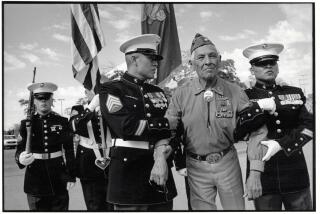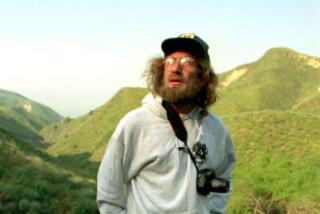Obituaries - Feb. 13, 1999
- Share via
Ducote ‘Duke’ Andrepont; Published First Offset Newspaper
Ducote “Duke” Andrepont, 80, a founder of the first newspaper in the nation to use offset printing. Andrepont was 21 when he teamed up with John R. Thistlewaite in 1939 to publish the Opelousas Daily World in Louisiana. It was Andrepont’s idea to abandon the cumbersome letterpress method of printing, in which type was set letter by letter and pressed against inked plates, in favor of the more economical lithographic or offset process, which used inked rubber-covered rollers to transfer images to paper. The first issue of the Daily World was published on Christmas Eve 1939. A copy of that edition is in the Smithsonian Institution in Washington. Other daily newspapers did not begin to switch to offset printing until more than a decade later. On Wednesday in Baton Rouge, La.
Leonard Arrington; Former Official Historian of Mormon Church
Leonard Arrington, 81, the first professional historian to be the official historian of the Church of Jesus Christ of Latter-day Saints. President Joseph Fielding Smith named Arrington church historian in 1972. The scholar headed a movement known as the New Mormon History, which strove to produce honest, evenhanded writing about the church’s past based on church archival materials. “We were trying to bridge the gap between pietistic history and professional history,” Arrington, himself a Mormon, wrote in “Adventures of a Church Historian,” a memoir published last year. He brought in two assistant historians from Brigham Young University and the University of Utah and encouraged students and interns to research previously untapped topics, such as the importance of women in Mormon history. From 1972 to 1980, Arrington’s team produced two one-volume histories, 18 published books, more than 100 articles for professional periodicals and a comprehensive oral history program. He was unceremoniously “released” from his post and his staff dismantled in 1980 after repeated attacks by several church apostles who said the work of Arrington and his colleagues “undermined faith.” Arrington continued to teach at Brigham Young until retiring in 1987. Mormon scholar Ronald Walker hailed Arrington’s recent memoir as “one of the most important 20th century autobiographies of a Mormon man of letters.” On Thursday in Salt Lake City.
Thomas Banyacya; Hopi Peace Emissary
Thomas Banyacya, 89, the last surviving member of a group of four Hopis chosen by elders to be peace emissaries to the world in 1948. That year, the Hopi elders learned with horror that uranium used in the atomic bombs dropped on Japan had been mined from Hopi land in Arizona. Hopi prophecies had predicted a gigantic “gourdful of ashes,” interpreted to mean nuclear weapons. Banyacya lived on the Hopi Reservation in northeastern Arizona, the oldest continuously inhabited community in the United States. As the last of the tribe’s “messengers,” he became an eloquent voice for the traditionalist point of view on a variety of contentious issues in the Southwest. He gained national prominence in the 1970s when he opposed strip mining adjacent to Hopi lands and repeatedly warned that the world faced global cataclysms if people failed to return to traditional ways of living in harmony with nature. Banyacya was specifically instructed to carry the prophetic messages to the United Nations, a mission he finally fulfilled in 1992, which the U.N. had designated the International Year of the World’s Indigenous Peoples. “What have you as individuals, as nations and as the world body been doing to take care of this Earth?” the Hopi leader asked in his address before the General Assembly. According to an account of that meeting published in 1994, there was a total lunar eclipse over New York City the night before Banyacya and other Native American representatives spoke; the day after the sparsely attended session, the U.N. building was flooded from torrential rain. On Saturday in Oraibi, Ariz.
Retired Col. Robert S. Scott; WWII Medal of Honor Winner
Retired Col. Robert S. Scott, 85, the winner of the Medal of Honor for action during World War II in which he killed 28 Japanese soldiers during a fierce battle on New Georgia in the Solomon Islands. Scott, then an Army lieutenant, held his ground when Japanese soldiers launched a fierce counterattack near Munda Airstrip. With only a tree stump for cover, he stalled the enemy and continued to fight even after his carbine had been shot from his hands and he had suffered wounds to his left hand and head. Scott used grenades to force the enemy back, killing the 28 Japanese soldiers in the process. After the war, he left the Army but reenlisted in 1947 and served until 1966, when he retired with the rank of colonel. A modest man, Scott “did not try to glorify his bravery,” his son James said. “He disliked it when people regarded him as a hero. He felt he had a job to do, and he did it.” On Feb. 5 in Santa Fe, N.M.
Whitney Tower; Racehorse Writer, Helped Found Racing Museum
Whitney Tower, 75, who wrote about racehorses--from Citation to Secretariat--and was the driving force behind the National Racing Museum and Racing Hall of Fame. Born to wealth, Tower was the son of Roderick and Flora Payne Whitney Tower. He was the grandson of Gertrude Vanderbilt Whitney, founder of the Whitney Museum in New York, and Charlemagne Tower, a railroad president. His great-great-grandfather was the railroad tycoon Cornelius Vanderbilt. Tower, a longtime racing writer for the Cincinnati Enquirer, Sports Illustrated and other publications, contributed to the sport’s golden era, reporting on the triumphs of champions including Citation, Kelso, Dr. Fager and Secretariat. His honors include the Thoroughbred Racing Assn. award for magazine writing in 1967 and the Eclipse Award for magazine writing in 1976 and 1977. He wrote “The Art of Race Riding” with Eddie Arcaro and “Saratoga, The Place and the People.” Tower also was director of the racing museum, in Saratoga Springs, N.Y., for eight years and was its chairman for 10 more years, supervising a major expansion. On Friday in Saratoga Springs of complications from a stroke suffered last year.
Benjamin Volcani; Microbiologist Found Life in Dead Sea
Benjamin Volcani, 84, a microbiologist who found life forms in the Dead Sea and helped uncover the secrets of silicon in aquatic plants. As a young researcher, the Israeli-born Volcani focused on the Dead Sea, which was once believed to be too salty to sustain life. Volcani found microorganisms in the body of water in 1936, which became the theme of his doctoral thesis. His doctoral degree in microbiology from Hebrew University in 1941 was the first of its kind from that institution. From 1939 to 1958 he served on the staff of the Weizmann Institute of Science in Israel, rising to head of microbiology there in 1948. He also studied as a research fellow at UC Berkeley, Stanford’s Hopkins Marine Station in Monterey, Caltech and the University of Wisconsin. Volcani began working at the Scripps Institution of Oceanography in 1959. It was there that he became the first scientist to show that silicon is essential for DNA synthesis in diatoms, single-celled aquatic plants that make up the base of the marine food chain. On Feb. 6 in La Jolla of complications of kidney failure.
Gideon Rafael; Israeli Diplomat
Gideon Rafael, 86, an accomplished diplomat who helped found the Israeli Foreign Ministry half a century ago. Rafael was born in Berlin and moved to British-ruled Palestine in 1934 after the Nazis rose to power in his native country. He was recruited by the Haganah, the Jewish armed force in Palestine, to negotiate a plan with Nazi officials to send German Jews to Palestine. When Israel declared independence in 1948, he formed the Foreign Ministry with Moshe Sharett, who became Israel’s first foreign minister. Rafael went on to serve in a variety of high posts over the next three decades, including permanent representative to the United Nations and ambassador to Britain. He retired amid the Egyptian-Israeli negotiations that resulted in the historic Camp David accord. Three years later, in 1981, he published a memoir, “Destination Peace: Three Decades of Israeli Foreign Policy.” On Wednesday in Jerusalem.


